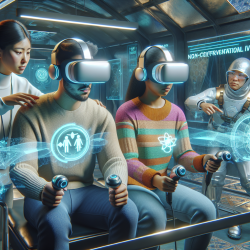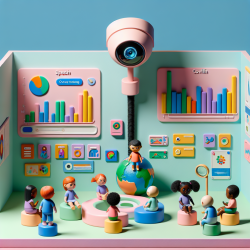Introduction
In the realm of education and beyond, the use of technology is reshaping how we approach complex social issues. A recent scoping review, "Virtual Reality or Augmented Reality as a Tool for Studying Bystander Behaviors in Interpersonal Violence," explores the potential of virtual reality (VR) and augmented reality (AR) to enhance bystander intervention strategies. This blog post delves into the key findings of this research and offers insights for practitioners looking to integrate these technologies into their programs.
The Power of Immersive Technology
VR and AR technologies offer immersive experiences that can transform traditional bystander training programs. By creating realistic scenarios, these technologies allow participants to engage in simulated environments where they can practice intervention strategies in a safe setting. This approach not only enhances the learning experience but also provides valuable observational data on bystander behaviors.
Key Findings from the Research
- VR has been effectively used as an observational tool to study bystander behaviors in various scenarios, including school bullying and dating violence.
- While VR shows promise, the research highlights a gap in the use of AR for studying bystander behaviors, suggesting an area ripe for exploration.
- VR environments allow for the collection of behavioral data, reducing reliance on self-reported measures and increasing the ecological validity of studies.
Implications for Practitioners
For practitioners in education and social work, integrating VR and AR into bystander training programs can offer several benefits:
- Enhanced Engagement: The immersive nature of VR can increase participant engagement and empathy, potentially leading to more effective intervention strategies.
- Data-Driven Insights: By collecting behavioral data in VR environments, practitioners can gain deeper insights into the effectiveness of their programs and make informed adjustments.
- Scalable Solutions: As technology becomes more accessible, VR and AR offer scalable solutions that can be adapted to various educational settings.
Encouraging Further Research
While the current research provides a strong foundation, there is a need for further studies to explore the full potential of AR in bystander intervention programs. Practitioners are encouraged to collaborate with researchers to develop innovative applications of these technologies, ensuring that programs are both effective and accessible.
Conclusion
As we continue to seek effective strategies for addressing interpersonal violence, the integration of VR and AR into bystander intervention programs offers a promising avenue for enhancing educational outcomes. By leveraging these technologies, practitioners can create more engaging and impactful learning experiences, ultimately empowering individuals to take action in real-world situations.
To read the original research paper, please follow this link: Virtual Reality or Augmented Reality as a Tool for Studying Bystander Behaviors in Interpersonal Violence: Scoping Review.










